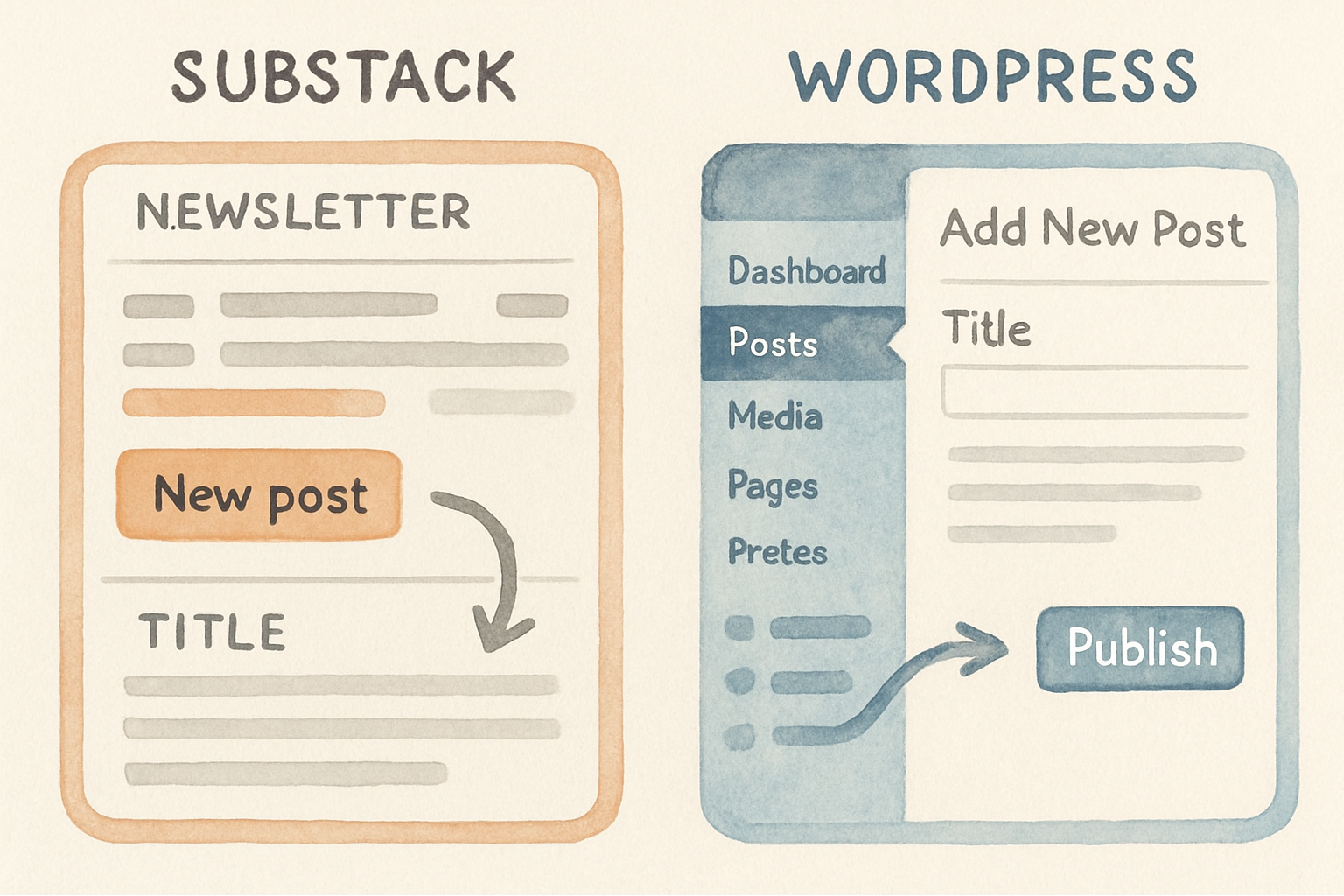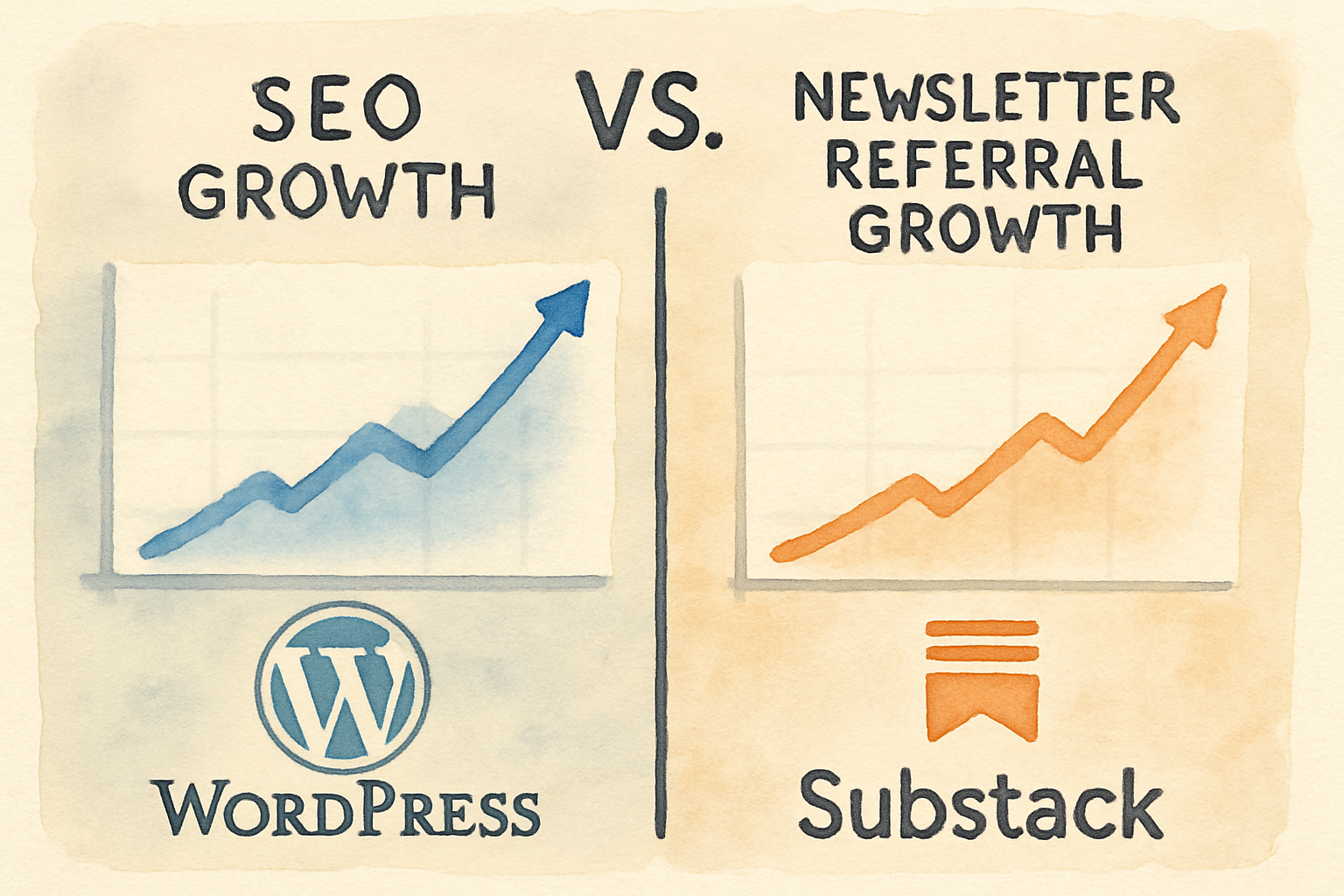Everyone knows that Substack and WordPress are two of the most popular platforms for online content creation.
But what are they, exactly?
This guide will give you the ultimate cheatsheet to decide between Substack vs WordPress as your go-to platform in 2025.
Some are looking for simplicity and minimal setup.
Some are eager for maximum customization and control.
Some crave newsletter-first audience building.
Some want fully fledged website management with deep SEO benefits.
Some create for income, others for community.
Let's dive right in.
Introduction: What Sets Substack and WordPress Apart?
The debate of Substack vs WordPress has gained massive traction as content creators evaluate their options for publishing, audience growth, and monetization in 2025. Both platforms shine but serve distinct purposes.
Substack is primarily a newsletter-first platform designed for independent writers and journalists who want to build communities and monetize through paid subscriptions. It streamlines content creation and distribution via email, making it easy to connect deeply with engaged followers.
Conversely, WordPress (specifically the self-hosted WordPress.org) is a powerhouse website-building and blogging platform enabling small to large businesses to create bespoke websites with granular control over design, content, and SEO.
Understanding these fundamental differences will guide your decision to pick the platform that aligns with your goals.

Setup and Ease of Use
The first impression counts, especially when launching your online presence.
Substack excels in simplicity. Signing up requires just an email and a few steps to create your newsletter publication. Its minimal and clean user interface ensures your only focus is content creation — no worrying about hosting, SSL certificates, or complicated installations. You can start publishing in minutes with a guided onboarding tour (source).
Similarly, beehiiv, a newer newsletter-first competitor, matches Substack’s ease of use but introduces some added growth and monetization tools.
By contrast, WordPress demands more initial investment. You need to purchase a domain, a hosting plan, and SSL certificates. Subsequently, the WordPress dashboard — while appearing straightforward at first — rapidly unfolds into a complex workspace filled with themes, plugins, and customizations. For newbies, setting up can take days or even weeks, factoring in learning and troubleshooting (source).
This heftier learning curve is offset by the immense flexibility WordPress offers once mastered.
Customization Options
Customization dramatically influences how your brand comes across to visitors.
With Substack, design options are tidy but limited. You can adjust logos, accent colors, backgrounds, and typography — but you’re working within a fixed newsletter and website layout. There's no drag-and-drop or page-building freedom, and you can't rearrange elements freely.
Imagine a carefully tailored, but pre-cut, suit versus a fully bespoke one.
beehiiv adds a bit more flexibility with its Newsletter Builder and Website Builder, allowing you to tweak how headers, images, buttons, and other elements appear across newsletters and archive pages. You maintain brand consistency without absolute design freedom.
On the other hand, WordPress is like the bespoke suit of the web. It offers complete design freedom through thousands of themes and powerful drag-and-drop page builders like Elementor or Divi. Customize every page — Home, About, Blog — to create an unmatched user experience tailored exactly to your brand’s voice. This versatility is essential for businesses or creators wanting a unique web presence (source).
However, this freedom demands time, design skills, or investment in premium tools or developers.
Content Publishing Capabilities
Publishing content efficiently and engagingly is central to either platform’s value.
Substack features a content editor reminiscent of Google Docs. It supports rich text formatting and easily embeds images, videos, polls, and even audio or podcasts directly into your newsletters, enabling a multimedia experience. Every post instantly lands in subscribers’ inboxes and archives online for new visitors (source).
It's ideal for those centered on newsletter distribution but can function as a basic blog archive, too.
WordPress utilizes Gutenberg, a block-based editor allowing insertion of tables, images, audio, video, and embedded social media content from YouTube, Spotify, Reddit, and more. WordPress primarily targets website/blog content, so your posts live on your site first, with newsletter functionality added via plugins for email syndication.
For example, plugins like MailPoet enable sending blog posts as emails to subscribers, blending WordPress’s power with newsletter reach.
beehiiv features a Notion-like writing interface, minimal and distraction-free, with advanced slash-command menus to insert multi-column layouts, tables, and embed social feeds. It also features a built-in AI assistant to brainstorm and translate content across multiple languages, streamlining production (source).
Community Building Features
Strong community engagement transforms casual readers into loyal fans.
Substack stands out with native community tools—beyond likes and comments, it offers real-time chat with subscribers, threaded discussions, and public Notes that work like microblogs to boost interaction within and beyond your audience. This fosters a tight-knit creator-reader relationship (source).
WordPress comes minimal out of the box, offering commenting on blog posts. Yet, with its huge plugin ecosystem, you can add forums, membership areas, direct messaging, social sharing, and more to cultivate community exactly how you envision it.
For creators preferring less community management, beehiiv limits features to reader likes, comments, and share buttons, prioritizing content creation over complex social features.
Quick Tip: If interactive community-building is vital, Substack’s built-in tools make it easy without third-party plugins or setup hassles.
Growth Tools and SEO
Your audience size can make or break your content business.
WordPress leads in SEO capabilities. It is crafted to be search-engine friendly from day one. It allows all your pages and posts to be crawled and indexed easily. Plugins like Yoast SEO and RankMath give granular on-page SEO control to skyrocket your rankings and organic traffic (source).
Think of WordPress as the seasoned SEO pro that tunes your site to attract Google’s spotlight.
Substack relies less on search engines and more on community discovery. Readers subscribe via a built-in recommendation engine and Notes feature that promotes visibility inside the Substack ecosystem. It’s similar in ethos to Medium, focusing on subscriber-driven growth.
beehiiv injects additional growth features including a recommendation engine, referral programs, magic (one-click) subscription links, and paid boosts to cross-promote newsletters. These tools enable creators to efficiently grow their audience both organically and actively (source).

Monetization Approaches
Generating income from your content is a common goal—how well does each platform enable this?
Substack offers a single monetization model: paid subscriptions. You can create up to three tiers (Monthly, Annual, Founding Member), granting paying subscribers access to exclusive content and community features like comments and chats. However, Substack discourages monetization through direct product promotion to keep the focus on subscription content.
A notable downside is its fee structure: Substack takes 10% of your earnings, which can add up significantly at scale — for instance, with 2,000 subscribers paying $5/month, your platform fees reach $1,000/month (source). This unscalable pricing model may deter creators wanting to maximize revenue.
WordPress lacks built-in monetization but shines via plugins and integrations enabling a vast array of income streams:
- Ad display networks on your site, earning based on clicks or views.
- Membership plugins for exclusive access subscriptions.
- Affiliate marketing management tools.
- E-commerce storefronts selling physical or digital products.
This flexibility demands more setup but rewards creators with diverse income control.
beehiiv combines the best of both worlds: it supports paid subscriptions with no revenue cut and also integrates ads, plus a unique "Boosts Marketplace" for earning by recommending others’ newsletters. Beehiiv permits external product and affiliate promotions inside newsletters freely, boosting monetization potential with built-in email marketing and audience segmentation tools (source).
Analytics and Integrations
Monitoring performance and connecting tools is crucial for sustained growth and efficiency.
Substack provides basic analytics: total views, open rates, subscriber growth, and top traffic sources. While useful for tracking newsletter health, it lacks deep insights or third-party integrations like Zapier or APIs, limiting expansion options.
beehiiv amps up analytics with detailed, visual dashboards displaying daily acquisitions, subscriber locations, top acquisition sources, plus unique insights into top-performing posts and links. It offers 12 native integrations (Stripe, Zapier, WordPress, Squarespace) and custom API/webhook support for broader tool connectivity.
WordPress doesn’t have built-in analytics but seamlessly integrates with industry-leading tools like Google Analytics and Search Console through plugins like Site Kit. This enables you to monitor traffic, user behavior, keyword rankings, conversions, and more at an advanced scale. With over 54,000 plugins available, WordPress can connect with virtually any software or platform a creator or business might need (source).
Pricing Structure
Your budget impacts your choice between Substack vs WordPress considerably.
WordPress is open-source and free, but you pay for hosting, domain registration, and SSL certificates — usually $60-$100+ per year. Free themes and plugins exist, but premium tools, templates, or developers can increase costs significantly depending on your customization and functionality requirements.
Substack requires no upfront fees and offers full features for free at the start. However, Substack takes a 10% cut on all your subscription revenue, which grows proportionally as your audience and income increase. This model can become expensive for creators scaling rapidly.
beehiiv has a generous free plan supporting unlimited emails to 2,500 subscribers. Paid plans start from $39/month for 1,000 subscribers with zero commission fees, offering better predictability for monetization. Higher tiers provide multi-publication support, unlimited teams, and branding control.
Pros and Cons Comparison
| Platform | Pros | Cons |
|---|---|---|
| Substack |
|
|
| WordPress |
|
|
| beehiiv |
|
|
Which Platform Should You Choose?
Determining your ideal platform depends heavily on your project’s specific needs.
If you want to launch a newsletter fast with minimal setup and focus on paid subscription revenue, Substack is often the go-to. Its community tools and straightforward publishing make it perfect for independent writers seeking engagement (source).
However, if your goal is a custom-built website or blog with full control over design, SEO, and multiple monetization paths, WordPress reigns supreme. Its extensive themes, plugins, and SEO-friendly architecture make it ideal for businesses and creators with more technical capacity or budget (source).
For creators wanting a newsletter-first platform with collaborative tools, growth hacking features, and flat-rate pricing, beehiiv offers a compelling middle ground. It balances simplicity with advanced monetization options like ads and Boosts, plus free email marketing tools to promote products and offers.
Remember, you can use Substack newsletter forms embedded in WordPress websites to blend both worlds — a common tactic to harness WordPress’s SEO power while capturing newsletter subscribers effectively.
Did you know? Many successful creators maintain a WordPress site as a central hub and use Substack or beehiiv primarily for direct newsletter engagement and monetization.

Frequently Asked Questions
- Can Substack replace a full website?
- No. Substack is focused on newsletters and basic blog archives but lacks website building and advanced SEO features to replace a full website experience.
- Is WordPress hard for beginners?
- WordPress has a learning curve and setup complexity but offers tutorials, themes, and plugins to simplify the process over time.
- Does Substack take a cut of my earnings?
- Yes, Substack takes a 10% fee on subscription earnings, which can be significant as your subscriber base grows.
- Which is better for SEO, Substack or WordPress?
- WordPress is superior for SEO due to customizable URLs, meta tags, and comprehensive plugins like Yoast SEO that optimize your content for search engines.
- Can I monetize on WordPress?
- Yes, WordPress supports multiple monetization methods through plugins, including ads, memberships, e-commerce, and affiliate marketing.
What's Your Next Step?
Tell us in the comments: How will you apply this to your content strategy across Substack vs WordPress?
For personalized advice tailored to your goals, contact us!
Want to explore related insights? Check out our detailed Substack vs Medium guide or dive into our Squarespace vs WordPress vs Wix comparison to broaden your platform scorecard.
Additionally, for cutting-edge creative inspiration, check out Mastering Smarts and Crafts, a guide blending traditional creativity with tech innovation.